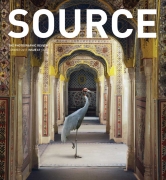Myths and Fables
An Interview by Roger Hargreaves with Karen Knorr
Issue 67 Summer 2011
View Contents ▸
View photographs from: Myths and Fables ▸
RH: One thing I was curious about was do you have any pets?
KK: No. But I do have a son. He’s twenty now. But I grew up with pets, I grew up in San Juan, Puerto Rico, in Punta las Marias, a residential area not far from the airport. We always had lots of dogs and there were land crabs in the garden and birds. I was born in Germany to American parents. My father moved our family there in 1958 when I was four. He was in business to import and export beef throughout Latin America and had set up a big freezing depot.
That sense of nature being very close is one of the first experiences I had as a child. I remember arriving in Puerto Rico and hearing this noise; the sounds of the crickets and the insect life. At that time we didn’t have air conditioning. The outside was as if it was inside. We’d go swimming and there were sea sharks and manatees.
RH: Can you explain about the manatees?
KK: I remember being fascinated by this animal that lived between the sea and the river in brackish water. The great lumbering manatees. It’s like a walrus without any tusks and has small fins and a big tail fin. They’re known as sea cows. Sailors used to think these were mermaids.
RH: Interesting that you were drawn to a mammal associated with myths and fables.
KK: They fascinated me. I remember researching them even though I was only five or six. But yes, myths and fables. I also collected these shells that were called bleeding teeth. I’d scramble over the rocks and prise them free. You had to boil them to clean away the snails. Hence I must have been doing very male activities. I was a really a tomboy. I now realise in going to India how much the West Indies echo with India. Columbus really thought he’d arrived in India and for a reason. The climate, fauna and fruit. Its extraordinary how similar it is to Puerto Rico before the development and the Americanisation of the island. I’d witnessed that period of ecological impact. Nature receded, the condominiums started appearing along the beachfront. Beaches disappeared when the dredging began.
RH: You say your mother was a photojournalist?
KK: She wrote things for Stars and Stripes and for some of the early German magazines. She reported on the Nuremburg trials. I have her archive which I haven’t looked at really closely. My mother came from a very middle class, mid-western, American family that was a mixture of Jewish and Scandinavian. Both my parents were cultured. We were always surrounded by great things, it was almost a museum environment. After the war my parents bought 18th century Louis Seize mirrors and a beautiful wall clock that were going for very little money. My mother collected miniatures and in the sixties we had German Expressionist paintings, George Grosz and Max Beckman. We sold them when my dad needed money to re-invest in the business. Things were up and down. It was a real dynamic financial roller coaster.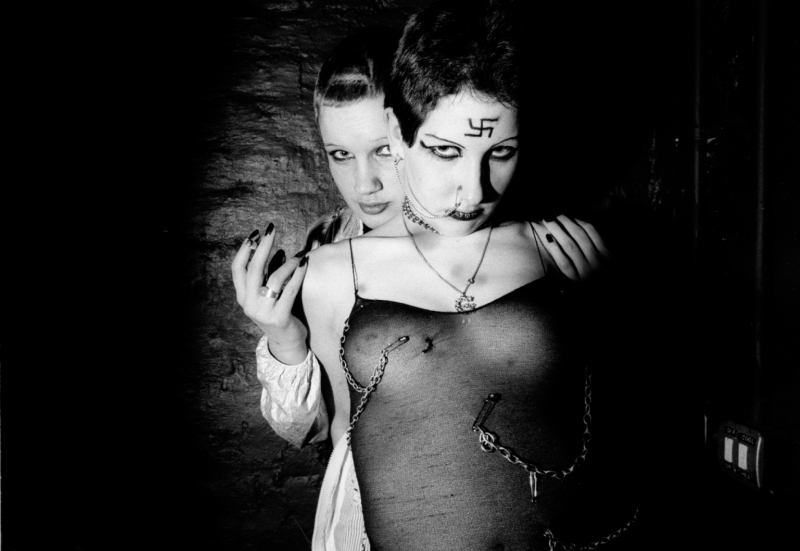 Roxy_1, About Punks (in collaboration with Olivier Richon), 1976
Roxy_1, About Punks (in collaboration with Olivier Richon), 1976
Although my dad was a businessman my parents were staunch Democrats. He was a communist when he was a young man. He worked in a factory in New Jersey to put himself through high school in the 1930s and became an active trade unionist. I grew up in a very liberal environment.
She also collected Santos (carved out of wood by Santeros) which are these saints, folk art between voodoo African and Puerto Rican mythology. There is a very syncretic nature to the Caribbean where it assimilates Catholicism, African and Taino culture. Thinking about that I grew up in an environment that collected, surrounded by a lot of books surrounded by a love of high culture. Thanks to my mum.
RH: What you’re also pointing to is a synthesis of cultures.
KK: Yes syncretic, always hybrid. I’ve always felt at ease with that sense of hybridity. That is what I now find in India and why I feel so at ease there. Of course middle class people speak English. I’m not saying I’d feel at ease in the slums of Calcutta. Who would? That’s a difficult situation. But generally I feel at ease there.
RH: How did you come to move to Europe?
KK: After Puerto Rico I went to study for a year in the States in this experimental college for rich kids, Franconia College in New Hampshire. Leon Botstein the conductor was principal. He’s now President of Bard College. The school was in a converted old fashioned ski hotel. I felt like a fish out of water. I was punched into American monoculture but I didn’t feel American at all. I didn’t feel at ease. It was also the end of the sixties and there was this sexual liberation going on which I didn’t feel I was part of. I couldn’t relate to the sleeping around. I found it quite oppressive. But Eileen Cowin, the photographer was teaching there. She spotted something there in my photographic practice and encouraged me. I moved to Europe in 1973 as a student studying art at an all women college in Paris. It was a three year course that prepared you for the Beaux Arts. I learnt French fluently and I stated getting into the museum culture. It was very traditional, life drawing classes like a foundation course.
So I was in Paris from 1973 -1976. I arrived in London in 1976 during the drought, the heat wave. People were rationing water. My parents had moved to London by then. I decided that I wanted to do photography seriously. I’d dabbled in photography at Franconia and Paris and thought, ‘This is ridiculous; I’ve got to get my act together.’
RH: What was your idea of photography at that point?
KK: My idea of photography was David Bailey; fashion photography. One of the first things I did in London was go and see David Bailey and ask him for a job. He suggested I go meet Patrick Duffy whom I met. I looked at what the assistants were doing and figured I wanted to learn how to do this properly. So I enrolled at a professional photography course at Harrow College of Technology and Art and built up a portfolio. I had a joint portfolio of punks – which I co-authored with Olivier Richon – and my own experimental, personal work. I had this very Rauschenbergian, self expression thing going on, as promoted by Eileen Cowin. I was interested in layering, working with gum Bichromate and lith film. It was process driven experimentation. It had no theoretical substance. I did a series of striptease of a friend of mine taking off her jeans and made these box pieces with lith film. There was no political agenda.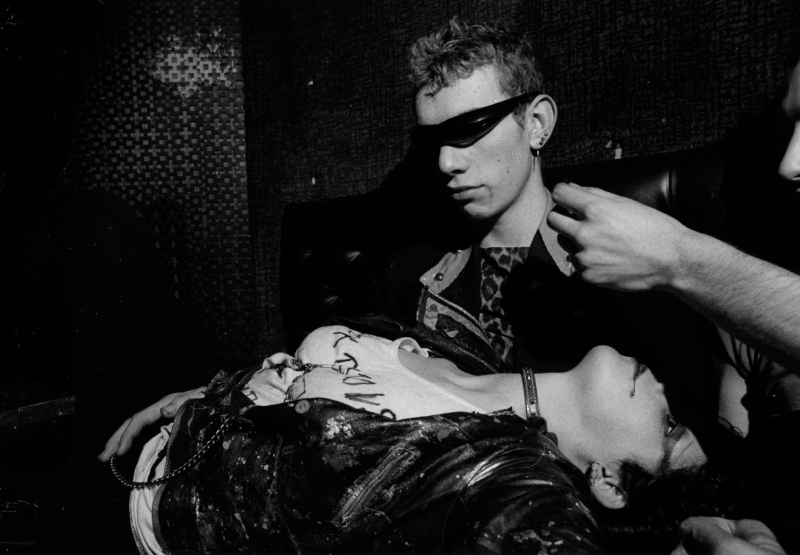 Roxy_1, About Punks (in collaboration with Olivier Richon), 1976
Roxy_1, About Punks (in collaboration with Olivier Richon), 1976
RH: The punks work though was quite different; the Situationists, tension, performance, key words?
KK: It was a performative collaboration. Olivier and I started developing this way of working intuitively. We knew we didn’t want to be paparazzi. We were helping each other. He did the lighting while I shot. I did the lighting while he shot. We said we’d never say who took which image. We were co-authoring everything. This was before PCL, even before we were imbued with this politically correct theory we were already developing this way of working.
I decided I wanted to submit to the Polytechnic of Central London. Everyone was talking about conceptual art and talking about Victor Burgin.
He was beginning to publish in Camerawork, his essays were being read. So I enrolled in 1977. I’ve never looked back since in a way. That course revolutionised the way I considered photography.
Up until that point I hadn’t a clue that you could use photography as a means of research to understand the world around you and apply it to history.
RH: Explain about PCL at that period. Was there a sense of tension? Were you drawn to one particular camp?
KK: Simon Watney and Maggie Murray taught there. John Goto was there. They were all very different. You could see all the different types of photography. There was an old guard of the people who were doing pinhole camera, process driven work and there was a real tension going on there between what to do and how to do it. Gus Wylie had a more Sunday supplement style. John Goto had a more Eastern European approach influenced by Sudek and others. Victor Burgin had a drier approach to the image, using text and had a fascinating way of contextualising the picture’s meaning.
That really appealed to me. I was taken over by that way of trying to engage with photography. I was drawn to the quality and beauty of the fine art print and the craft. The technicians would be grumbling about how I was the last one out of the darkroom. I always wanted the perfect print. I wanted to marry that fine art aesthetic with conceptualism. I am really looking forward to my Deb party.
I am really looking forward to my Deb party.
RH: While at PCL you produced your series, Belgravia. Can you explain the genesis of this work?
KK: Bill Owens came to the college and gave a talk in 1978. He was talking as if he was an anthropologist looking at this Northern California suburb. But he would always say he photographed things exactly as they were and when he used the captions in his books, that was exactly what people said. So I looked at that and I said, ‘I want to do something more constructed.’
Belgravia was more of a performative event, using some lessons from conceptual art. And then with the text I wanted to look at conceptual art and what had been done by Victor and look at advertising and editorial and use some of those lessons but lace it with humour and irony.
I was interested in the different levels of meaning that could come through the text. It could be very straightforward like, ‘I am looking forward to my Deb Party’ alongside an image of a young woman in a taffeta dress with a dog looking at us as a spectator.
One thing I did learn from Bill Owens was ‘photograph your own kind’. Also, having read Benjamin, The Author as Producer, thinking of ways of engaging with one’s own class, I decided I wanted to do this document of Belgravia. And no one had done it, or when it had been done, it had been done by people like Lord Snowdon and was celebrity driven, a who’s who. I decided I wanted to do something I was calling ‘non portraiture’ in that it was portraiture but it’s wasn’t about the proper name and about individual status. It’s about the status of a group of people and their aspirations, not about celebrity.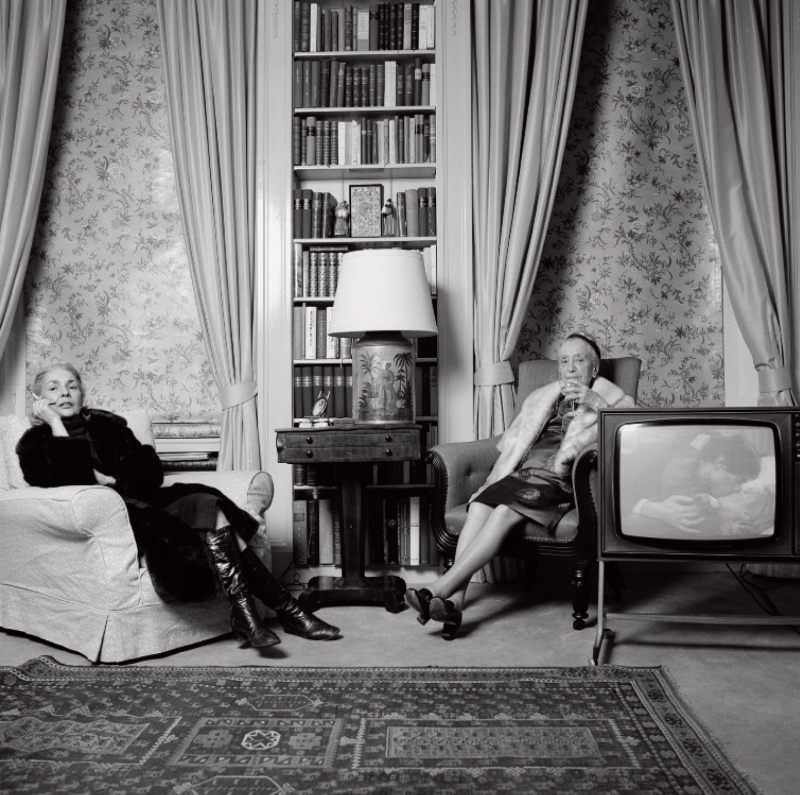 I live in the nineteenth century the early nineteenth century I am fascinated by Napoleon and Metternich two antagonists.
I live in the nineteenth century the early nineteenth century I am fascinated by Napoleon and Metternich two antagonists.
RH: To what extent was the project autobiographical?
KK: I started with a portrait of my mother and my grandmother in Belgravia. My parents had bought a twenty-five year lease on a maisonette in Lowndes Square. ‘I live in the nineteenth century. I am fascinated by Napoleon and Metternich. Two antagonists.’ That’s my mother’s quote. She and my grandmother were the antagonists. The weird thing was that about twenty years later I realised, well actually this is me too. That’s how I was brought up. OK my parents were liberals but some of their friends were like that. It was as if this was a masquerade of different versions of me being paraded under the image.
I had always staunchly said ‘This is not autobiographical’. Twenty years later I confronted the idea that these are people I could have become but people I didn’t want to become. I have this outsider status but within. I teach but I have my own work. I’ve always felt uncomfortable being placed in a very tight institutional context or being placed in a certain class. I’m American but I’m not. It’s like I’m from the outside but on the inside.
RH: Which other artists you were interested in at the time?
KK: Martha Rosler, Robert Cumming, Ed Ruscha. And I loved Diane Arbus.
RH: You mention Diane Arbus. How did you negotiate with your sitters?
KK: I would spend many, many hours having to be their friend and having to talk to them. People always have some very nice qualities. I’m curious about them. I want to know about people, they tell me about themselves. I wasn’t a journalist. I didn’t have a tape recorder. So what I’d do if they said something quite amazing which I was afraid I’d forget I’d excuse myself and scribble it down on a pad and then translate it when I got home. I found some extraordinary quotes that way. But they’d invite me in for tea or dinner as the girl next door. My mother was very complicit. She had a great sense of humour and irony. We both constructed her caption together and laughed our heads off.
But some of the people were totally literal. The woman in furs for example. The caption reads, ‘I believe a woman should keep her kitchen clean. I walked into a friend’s kitchen and saw two servants squeezing oranges, the sweat pouring off their foreheads into the juice. I did not allow my son to drink it.’ I went, doesn’t she realise the evil nature of what she was saying. So I put that caption under her picture.
When I first exhibited it at the Five Photographers show at the ICA someone commented, ‘It’s like that in Egypt as well’. So I realised that the whole series was dependent on irony and critique and the context in which the work was published and shown. There was no fixed reading of the work. My fantasy was that by humour I was sending it up and this was a questionable world that took this lifestyle for granted.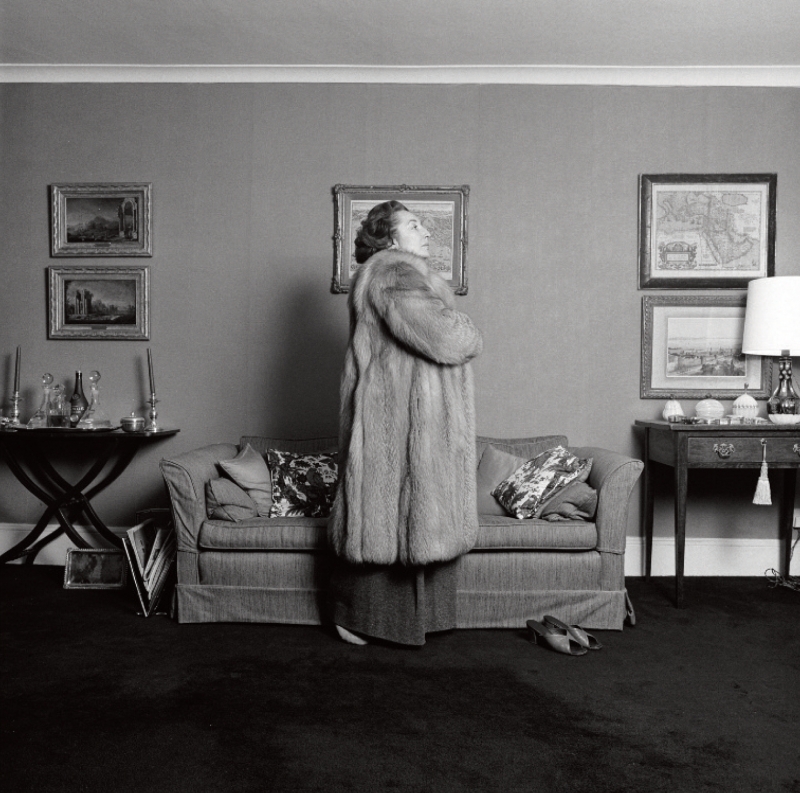 I believe a Woman should keep her kitchen clean. I walked into a friend's kitchen and saw 2 Servants squeezing oranges the sweat pouring off their foreheads into the juice. I did not allow my Son to drink it.
I believe a Woman should keep her kitchen clean. I walked into a friend's kitchen and saw 2 Servants squeezing oranges the sweat pouring off their foreheads into the juice. I did not allow my Son to drink it.
RH: Your most recent work is made in India. Why India?
KK: Anna Fox, whom I work with at the University of the Creative Arts, had started developing exchanges with India in 2007. She came across a gallerist at Tasveer in Bangalore. She mentioned my name. Abhishek Poddar looked at my website and got on the phone and said ‘You have to come to India.’ I didn’t go for any grants. I wanted to do it fast. Thanks to the internet I found places that might be equivalents to the museums spaces I’d explored in Fables yet very distinctly Indian.
Through contacts I was able to develop a network of people who agreed to me coming to the palaces and photographing rooms that weren’t open to the public. That very first trip I did a recce across Rajasthan. What I loved the most was this syncretic hybrid between Muslim and Hindu architecture.
These rooms had not been lovingly documented. There were snapshots of them that had appeared in interior, travel and coffee table books, but they’d not been photographed in any sustained way. The other thing that struck me about India was the animal life. Cows are kept as revered animals throughout their lives. They’re not eaten, they’re barely milked. They’re given shelter, they’re fed by the community and live with the family in the front room.
What appealed to me in photography was what Andre Bazin has to say about the corpse behind the portrait and the nature of embalming. Photography does stuff people, it taxidermies them. Especially when I look back at the Belgravia people who are all dead now. It’s ghost-like too. That’s very appealing. It’s not a surprise that the taxidermised animals in some of my recent work appear life like and the live animals I’m working with now look dead.
So I developed this work that combines several threads in my practice. The document, which is the architectural space, which is quite frontal. The symmetry, which I found there and I used. The sense of multiple moments which I’d developed in Fables, where you’re taking elements at different times and bringing them into one space which changes it from being an analogue photograph. Also this allegorical story telling impulse where I’m referencing femininity, the gilded cage of the Zanana, the women’s space in the palace and the Mardana, the men’s space. I was very conscious of the gender division of space just as I had been in Gentlemen, the series of works I’d made in Saint James Gentlemen’s clubs (1981-1983).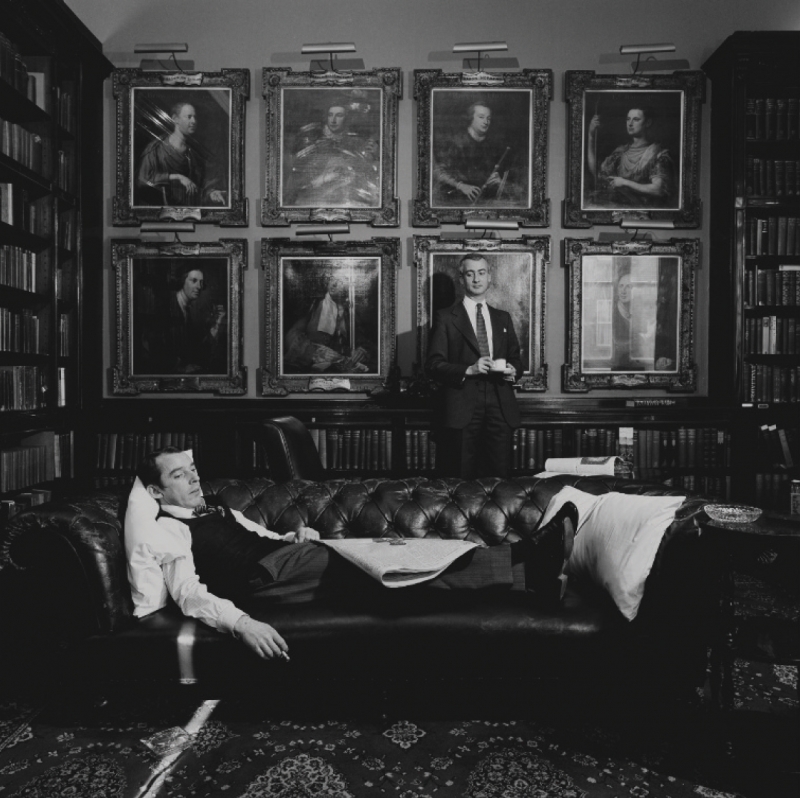 The Recapture of the Territory is no more than an Appetiser to the big Match.
The Recapture of the Territory is no more than an Appetiser to the big Match.
I photographed in Udaipur, Jaipur and Dungarpur. I photographed the Havelis in the Shekawati which developed 18th and 19th century wall drawings which were like newspaper events featuring celebrities and worthies of the time. The narratives refer to the Ramayana and Mahabharata but also to current news. So I found this extraordinary visual culture and storytelling and what I loved about it most was the blending of the past, present and the future. Wherever you go in Rajasthan, even in the middle of the desert, you’re connected to Wi-Fi. It’s very technologically developed.
And yet there’s the caste system like the class system here. So I was interested in making work that refers to it but in an open way without being too literal, that affords degrees of critique. So for example in the piece, Manu’s Law Revoked I’m referencing Manu’s Law which is the most anti woman, patriarchal law under the Hindu caste system. I’m referring to Indian culture and some of the problematics of the Indian way of life that still co-exist with rapid development, but then inserting this in places of fantasy which are still there and still alive.
Some of these are private palaces where the owners are lovingly restoring the space. There are nineteenth century photographs in the walls, so photography is literally embedded in the wall with text, drawings and mirrors. I was very drawn to this combination of Muslim architectural space but with this excessive delight of Hindu culture. There’s a side of Muslim culture which is incredibly puritanical. But what I discovered in India was there was an aspect of Muslim culture in the 16th century under Akbar who created the Fatehpur Sikri which was open, tolerant and engaged with critical debate. He had people in his Durbars, men of course, who were atheists, Christians, Jews, Parsis discussing the nature of life. I was interested in referencing Muslim culture at a very fraught period of history when in the West we’re being very anti-Muslim.
RH: Can you talk about the idea of Animalism in your work?
KK: The animal is central to Indian culture. Animals were often in and a part of the spaces I was photographing. The Sarus crane which is the largest, almost man-sized crane, were kept as palace guards by Mughal kings. The crane barks like a dog. There were cheetahs across Rajasthan.
In Hindu religion Hanuman the monkey god is the best known. Devi is the Goddess who takes different forms. There’s Ganesh the elephant god. So I was interested to bringing these references into the photographs. The animals are photographed separately. These are live animals. I have seen monkeys hanging out in palaces but it’s difficult to bring themtogether in one image as there’s very bright light and very dark interiors to keep cool. So I’d make ten second to a minute exposures for the interiors and 1/150th second exposures of the animals in nature reserves and zoos. I’ve made my list. I’m looking for them all the time. I’ve been photographing animals indigenous to India. I’ve recently photographed Bengal tigers and white tigers before they all disappear. So in a way it’s another embalming process.
As is photographing the palaces. Some of these places are protected but a lot of them aren’t and are crumbling and are being vandalised. I went to this temple in Madhya Pradesh and a lot of the heads of the gods had been lobbed off and vandalised. Maybe you have to let go of things and realise that they will be destroyed. The nature of life is destructive.
RH: What’s been the reception to your work in India?
KK: It’s been extraordinary. I’ve had more press in India than I’ve had in almost ten years of my career in Europe. I’ve even had a cover and a portfolio inside Elle Decor. I’ve won a Photography Prize for the first time in my life, the Pilar Citoler International Photography Prize. With the prize there’s an exhibition at the Sala Puerta Nueva de Córdoba and a monographic publication of 280 pages. I’m very taken aback by it. It’s been said about India Song that it is because I have immersed myself in Indian culture, I am not photographing the disadvantaged and the slums of Mumbai. I am photographing another aspect of high caste culture focusing on myth and storytelling using animals like avatars or actors.
There’s an aesthetic that’s very Indian and European and baroque. It’s also linked to magical realism in Central America where I grew up. In a way, visually that’s magical realism.
RH: Has this re-energised your practice?
KK: Yes, now I want to make videos and films between stills. I’m also making work that refers back earlier projects because of where I’m photographing the new India. It’s hard to find the right captions. I’m endlessly making work. I’m on a roll of creativity. I’m not blocked. I want to take it while it flows forth before I become too old.
Other articles by Roger Hargreaves:
Other articles mentioning Karen Knorr:





